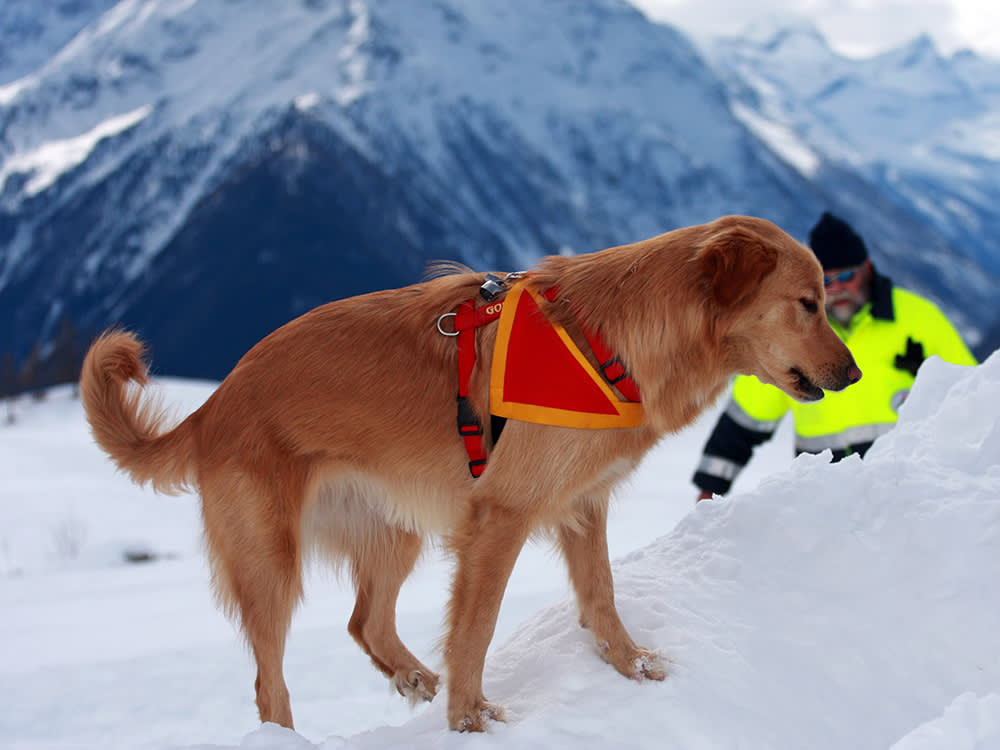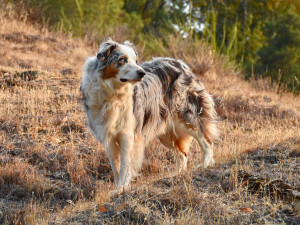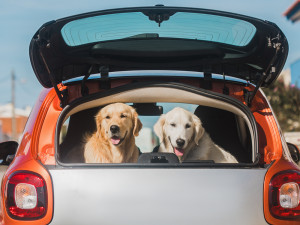Paw Patrol: How Avalanche Rescue Dogs Make the Slopes Safer for Everyone
Meet the pups who are saving lives, one rescue at a time.

Share Article
On a cold February morning, a Golden Retriever named Rocky and his human John Alfond quickly climb into the backseat of the Flight for Life helicopter. Rocky scoots to the far side next to the window. Alfond slides in beside his dog, followed by the avalanche technician. The liftoff is fast and hectic, and Rocky leans into Alfond for reassurance. It will take them 12 minutes to reach the Arapahoe Basin Ski Resort, and every second counts. Rocky, an avalanche rescue dog in training with the Colorado Rapid Avalanche Deploymentopens in a new tab program, is being transported to a disaster.
Avalanches threaten not only skiers and snowboarders but also snow-mobilers and ice climbers. According to the Colorado Avalanche Information Center, 27 people on average die in avalanchesopens in a new tab each year. The risk is the highest in Colorado, which has more than 1 million acres of avalanche terrain and a notoriously unstable snowpack.

Get (totally free) deals for food, treats, accessories, tech, and way more pet parenting must-haves.
opens in a new tabAvalanche Rescue Dogs
When the Flight for Life helicopter touches down, police officers and members of Arapahoe Basin’s ski patrol are waiting. They brief Alfond and team on the incident — a man in his mid-40s witnessed an avalanche. The man wasn’t affected, but he saw others swept away. No one is sure how many people are buried. Rocky paces on the end of his leash.
Alfond, himself a member of the ski patrol in Vail, assesses the scene’s safety. He identifies the wind direction, and looks for signs of more slides — cornices, or snow that could shift. Time is critical. After 15 minutes, nine out of ten people, or 90 percent, will survive an avalanche. After 30 minutes, that percentage decreases to 50.
Once Alfond is comfortable that the snow pack no longer presents an imminent danger, he asks Rocky to sit, and he obeys. Alfond gets down on his knees and looks Rocky directly in the eye. “Are you ready to work?” he asks. Rocky sits tall and holds Alfond’s gaze. He’s ready. Alfond unclips the leash. “Find it!” he says. Rocky bolts.
The dog immediately identifies a partially buried man, alive, but with head and leg injuries. Alfond praises Rocky, who romps with glee, and then asks him to sit. “Are you ready to go back to work?” he asks. Rocky turns serious again, and Alfond issues the “Find it” command a second time. After several minutes, Rocky identifies two more victims, fully buried, and begins to dig them out. Alfond determines that both are dead. Rocky is still praised, as his job is to “daylight” avalanche victims — to locate and unbury bodies, alive or dead.
Alfond sends Rocky back to work to “find it” one more time, but he turns up nothing. Alfond radios in the coordinates of the bodies as the avalanche technician loads the injured man onto a sled. Rocky follows. Total time from when they stepped off the helicopter: 23 minutes.
Once Alfond and the team rejoin the rest of the group, the mood turns celebratory. The incident was a simulation, and Rocky performed exceptionally well. The two “bodies” are volunteers, members of Arapahoe Basin’s ski patrol, as is the “injured man,” who hops off the sled and starts to wrestle with Rocky. “He’s ready for certification,” Alfond says, high-fiving the avalanche technician.
The next month, Rocky passes his certification test at Copper Mountain Resort, along with a Labrador named Mookie and his human Caroline Stone. The two dogs officially become the second and third members of Vail Resort’s certified avalanche-dog team. “I was more stressed than Rocky was,” Alfond says. “When it comes to avy dogs, humans are the dumb end of the leash.”
Born to Rescue
From the start, Rocky was destined to be an avalanche — or “avy” — dog. Alfond became interested in avy dogs in 2009, during his first year with Vail Ski Patrol. The resort was testing the effectiveness of using dogs with the help of a Golden Retriever named Henry, handled by his owner Chris Reeder, a patrol supervisor. During Alfond’s second year, Henry’s assistant handler left the patrol and Alfond and Stone took his place as co-assistants. By the third year, Vail’s avalanche-dog program was ready to expand. Alfond went to work identifying a qualified breeder.
Rocky was born April 4, 2011, at Hunters Trace Kennel in southeastern Wyoming. Alfond chose the kennel because owner Marsha Greenwell had successfully put four other dogs into ski patrol programs. “There are specific traits I look for in a puppy for avalanche rescue,” says Greenwell, “but the most important factor is the dog’s genetics.”
For snow rescue work, Greenwell breeds dogs with pedigrees proving good health and strong joints, as well as successful hunting or field-competition backgrounds. She feels that hunting and field dogs have attributes that are also desirable in avalanche dogs: they are intelligent, bold but not reckless, and possess the perseverance to work and search.
Once the dogs have been bred, she selects puppies who can distinguish scents easily, demonstrate a strong work ethic, are confident and playful, and know when it’s time to rest. The key trait she looks for, however, is eye contact. “It’s been proven that dogs communicate through eye contact,” she says. “They get a lot of their instruction from us by what we’re saying to them with our eyes. It’s how they learn to trust in scary situations, like getting into a helicopter.”
By the time Rocky’s litter was five weeks old, Greenwell had selected two possible avalanche dog candidates. At eight weeks, she’d narrowed it down to just one — the male with the gold yarn around his neck. “She was right,” says Alfond. “Rocky is smart, has a great temperament and a strong work drive, and loves to search.”
Alfond gave Rocky four weeks to get adjusted to his new home before starting training. The Alfond household includes two children and two other Golden Retrievers; fortunately, Rocky fit in well. The pup’s first lessons lasted five minutes, building up to 20. After Rocky mastered the basics like sit and come, Alfond started laying the foundation for the commands essential to search-and-rescue work.
Alfond would ask Rocky to sit; once he’d done so, a friend or family member would hold the dog. Next, he’d ask Rocky if he was ready to work, and then walk 10 to 20 feet away. Watching his human “leave,” Rocky would become anxious to follow (hence the need for someone to hold him). Finally, Alfond would issue the most critical command in the search-and-rescue dog universe: “Find it!”
The friend or family member would let go of Rocky and he’d run directly to Alfond. Praise, play and treats were part of Rocky’s reward for a successful “find.” “When they get good at that, then you start to hide, like ducking behind a rock,” says Alfond. “Eventually, you hide downwind from them, without [letting] them see where you hide, and they find you based purely on scent.”
After a summer and fall of preliminary training, Rocky was ready to try his new skills in the snow. Alfond started Rocky with basic burial drills, in which the dog is held as he watches a person crawl into a snow cave, and then released with the “find it” command. Rocky progressed to finding someone who had been buried in the snow out of his sight.
Later, Rocky and Alfond traveled to the Snowbird and Alta ski resorts in Utah to attend the four-day WBR International Dog School. The oldest and most prestigious program of its kind, the school includes instructors from Wasatch Backcountry Rescue, Canadian Avalanche Rescue Dog Association, Swiss Alpine Club, Alaska SAR Dogs and the International Commission for Alpine Rescue. By spring, Rocky had mastered avalanche simulations like the one at Arapahoe Basin. His total training and preparation for Colorado Rapid Avalanche Deployment (CRAD) certification took two years.
The Avalanche Dog Difference
The CRAD avalanche dog rescue certification trial takes place in a 200-by-200-meter test area at a ski resort. It requires the avalanche-dog-in-training to daylight one to three victims buried beneath six feet of snow in 30 minutes or less. CRAD has been certifying dogs and their humans since 2006. The program isn’t the only certifying body in Colorado, but it’s the largest, encompassing more than a dozen resorts, including Aspen, Breckenridge, Keystone, and Vail. According to Jeff Thompson, who oversees the avalanche dog division at CRAD, about 10 dogs are certified each year by the organization.
“As the number of people recreating at ski resorts and in the backcountry continues to rise, more resorts are starting to see the benefits of avalanche dog programs,” says Thompson, himself an avy dog handler and a member of the Beaver Creek Ski Patrol.
Thompson, who has participated in more than a dozen avalanche SAR efforts with his dog, a Labrador named Dixie, created Beaver Creek Resort’s avalanche dog program in 2000. “In the winter, you have to be ready at a moment’s notice,” he says. “When Flight for Life responds, they look for the closest avy dog to the scene.”
Thompson doesn’t mince words when it comes to avalanche survival rates. Ski patrollers understand that the best way to survive an avalanche is to not be caught by one in the first place. The hard fact is that by the time avalanche dogs and their handlers reach a site — by helicopter, snowmobile, skis or all three — it’s usually too late for the victim.
At 30 minutes, the avalanche survival rate is 50 percent, and that percentage drops to 20 after two hours. “We always respond as fast and as efficiently as possible with the thought that we’re going after a live body, but more often, that’s not what we’re finding,” says Thompson. Alfond agrees. “An avalanche dog is not a magic bullet.”
As he and Rocky head toward their first ski season as a full-fledged avalanche dog team at Vail Resort, Alfond acknowledges that there are serious on-the-job risks. In addition to avalanche danger, there are other hazards, such as frostbite or Rocky accidentally getting cut by a ski edge while running beside him to a rescue. Yet Alfond appreciates the rewards of his job. “If we rescue just one person, or bring just one body home to a family, it’s worth it.”
Alfond sees another benefit to having avalanche dogs as part of a resort’s ski patrol team: they’re great for public relations. Ski patrol members are not typically known as the most approachable skiers on the mountain. Quite the contrary — they’re the ones who bust you for ducking a rope and to get to the untracked powder out of bounds. But when avalanche dogs are around, suddenly people want to interact. “Guests actually come into our office just to pet them,” says Alfond. “And we get a lot better reception at schools during our snow-safety presentations when the dogs are there.”
Avalanche rescue dogs may be a ski resort’s best chance at decreasing the avalanche death toll. Dogs put a friendly face on snow safety outreach programs. They give the ski patrol an opening to talk about the importance of carrying a shovel, beacon, and probe into the backcountry, and knowing how to use the gear in an emergency. Mountain rescue dogs in their red vests make people smile, and may make them more attentive to messages about using common sense in the backcountry, including having a partner and carrying a cell phone.
The presence of avalanche dogs at ski resorts helps make people more snow-safety conscious — and that’s a feat worth wagging about.

Jayme Moye
Jayme Moye is an award-winning journalist who writes about the people, places, ideas and events that are changing the way we think about the world. She is a Senior Writer with Kootenay Mountain Culture and her freelance work regularly appears in Outside, Canadian Geographic, National Geographic, and Condé Nast Traveler, among others.

